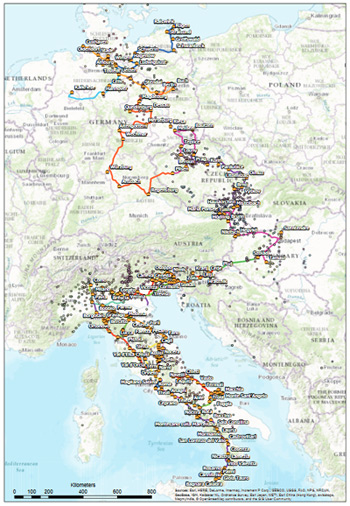Macro-paths
 The cultural Route “Longobard Ways across Europe” consists of a basic itinerary that follows the original European geocultural corridor traced by the historic migration of the Longobard people from the seas of the North to the middle course of the Danube and its tributaries, to the banks of Lake Balaton, the entire Italian peninsula and the Mediterranean coasts of Southern Italy.
The cultural Route “Longobard Ways across Europe” consists of a basic itinerary that follows the original European geocultural corridor traced by the historic migration of the Longobard people from the seas of the North to the middle course of the Danube and its tributaries, to the banks of Lake Balaton, the entire Italian peninsula and the Mediterranean coasts of Southern Italy.
In its structural composition, the basic route of the “Longobard Ways across Europe” consists of a macro-paths which, in the first two macro-areas (“Lands of the Elbe” and “Lands of the Kings”) combines the focus points based on:
- architectural finds recognized as products of Longobard material culture;
- the presence of Museums in which these finds are exhibited;
- the characteristics of the landscapes which, considered from the point of view of proto-history and history, can reveal something about the system and aims of the settlement of the ancient Germanic tribes and in particular of the Longobards.
MACRO-ROUTE
"Lands of the Elbe" Ways / macro-paths
In the first macro-area (“Lands of the Elbe”), the macro-route starts off from the Hanseatic city of Stade and follows the course the river towards its source, touching the main North Germanic focus points identified thanks to architectural finds recognized as products of early Longobard material culture.
Future research will be undertaken to identify the most reliable path that the Longobard peoples may have followed from the middle course of the Elbe to the area of Central and Eastern Europe, with the possible inclusion of Poland in the Route system.
- Cuxhaven-Stade-Buch
- Lüneburg - Ralswiek
- Kalkriese- Lüneburg
- Buch/Berlin-Regensburg-Pilsen
"Lands of the Kings" Ways / macro-paths
In the second macro-area (“Lands of the Kings”), the Route is based on a similar criterion to the one adopted for the first macro-area. The macro-itinerary therefore develops touching the main archaeologically proven focus points, mainly in the areas of Brno, Znojmo and Prague; in the areas of Lower Austria the centres of Mödling, Asparn an der Zaya and Vienna; in the Hungarian regions, in particular the areas of Györ-Sopron, Vàrpalota and Tolna.
When passing from the area of Central and Eastern Europe to Italy — the final section of the epic migration of the Gens Langobardorum — the macro-Route follows the only easily accessible roads: the route of the old Roman roads.
An important junction on this part of the European route is the area of the Slovenian city of Kranj, the territory of which was the site of the Longobard settlement closest to Italy in the period that preceded the invasion of the Italian peninsula; and, vice-versa, it is the most distant point of control after the conquest of Italy.
From Ljubljana (Emona) to Cividale del Friuli (Forum Iulii) the macro-Route follows almost completely the Roman road of the Via Gemina, which linked Emona to the upper Adriatic metropolis of Aquileia.
- Mèlnik-Mistelbach
- Mèlnik-Pilsen
- Alboin route- 1 (from Hungary, through Slovenia to Italy)

ITALIAN WAYS
From Ljubljana (Emona) to Cividale del Friuli (Forum Iulii) the macro-Route follows almost completely the Roman road of the Via Gemina, which linked Emona to the upper Adriatic metropolis of Aquileia.
Italy is absolutely the richest area as regards the history of the Longobards and the archaeological, artistic-monumental and religious references to the people.
In the peninsula, the way followed by the macro-Route consists of the sum of the different paths identified from the descriptions in the Historia Langobardorum by Paul the Deacon concerning the military campaigns of the conquest, and based on events that include journeys and objective confirmation of the use of roads and passes through the Apennines and the crossing points of the Byzantine Corridor that separated the Longobard territories in the North from the Duchies in the South.
Further variants of the macro-Route in Italy are offered by the paths of the old pilgrimages, in particular those heading to the sanctuary of Saint Michael the Archangel on Mount Gargano, which comprise both ancestral sheep tracks and the ways of the so-called Via Sacra Langobardorum.

“Lands of the Kingdom” Ways / macro-paths
- Alboin Path 2 (from Slovenia’s border)
- Adelperga's Path
- Autari's Path
- Paths of the Apennines (Via del Monte Bardone-Cisa; Via Cassiola; Way of Saint Colombanus and the Abbots; Umbria-Marches Road

“Lands of the Princes” Ways / macro-paths
- Via Sacra Langobardorum
- Via Herculea
- Tratturo Magno
News
-
2025 21 MarchERRATA CORRIGE CONVEGNO DONNE LONGOBARDE
-
2025 19 March
-
2025 19 MarchDa Salerno a Monza: convegni nel nome delle mulieres longobarde
